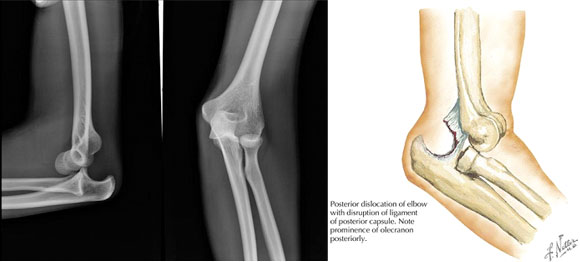


Dislocation of the elbow is not a very common condition. The elbow joint itself is stable and requires a fair amount of force to dislocate it. The commonest cause for this is a fall on the outstretched hand which pushes the forearm upwards towards the shoulder if the elbow is in a rather straight position. It is excruciatingly painful and the patient loses complete use of the arm after this injury. Most patients come as soon as the injury happens as it is very painful, and the elbow looks very deformed.

Clinical assessment of the patient involves checking for any injury to the nerves or the artery around the elbow.
Investigations in form of X Rays are also taken specially because it is imported to rule out any Bony injuries sustained at the same time. There is significant chance of fracture of the radial head and coronoid process of the forearm bones. Both are parts of the main bones around the elbow. It is to be taken that some ligaments which hold the elbow together would almost surely be damaged.
The emergency treatment involves pulling the elbow and reducing it to a normal position at the same time checking its stability. If it appears stable a small period of rest in a temporary cast can be given. Once pain and swelling subsides the patient can be allowed to start elbow movements.

Movements are initially quite stiff but given physiotherapy and effort by the patient elbow should return to normal.
If, however the elbow is unstable or if there are associated fractures then they need to be managed on their own merit. The essence of treatment is currently immobilization and preventing any recurrent instability of the elbow.
There is a condition called posterolateral rotatory instability (PLRI) in which surgery become essential. This would involve fixing of the radial head or replacing it along with repair of the ligaments on the sides of the elbow. The diagnosis of this may involve getting a CT scan or MRI scan. Thus, diagnosing it early makes eventual the difference in the long term prognosis and usage of the elbow. The elbow joint is very prone to develop stiffness and immobilising in plaster for a long time is not an option

Occasionally the elbow shows problems like developing excessive bone around it (Heterotopic ossification) which needs to be managed very cautiously as it might impair the movement of the elbow completely. There are lot of nerves around the elbow which need to be carefully checked after these injuries. Local therapy such as massage is now strictly not advised as it causes a lot of other problems.